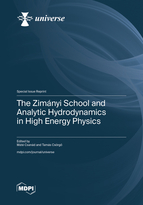The Zimányi School and Analytic Hydrodynamics in High Energy Physics
A special issue of Universe (ISSN 2218-1997).
Deadline for manuscript submissions: closed (31 March 2019) | Viewed by 73268
Special Issue Editors
Interests: hydrodynamics in high-energy heavy ion physics; Bose–Einstein correlations; femtoscopy; forward (small-x) processes in particle physics
Special Issues, Collections and Topics in MDPI journals
1 RMI, MTA Wigner FK, Konkoly Thege 29-33, H-1121 Budapest XII, Hungary
2 EKE KRC, H-3200 Gyöngyös, Mátrai út 36, Hungary
Interests: Quark–Gluon plasma as a perfect fluid, exact solutions of hydrodynamics, diffraction in high-energy physics, femtoscopy, particle correlations, Bose–Einstein correlations, Hanbury Brown–Twiss effect in high-energy physics, pion lasers, high-energy heavy ion physics (both theoretical and experimental), high-energy particle physics (both theoretical and experimental), technology transfer and outreach
Special Issue Information
Dear Colleagues,
In collisions of relativistic heavy ions, circumstances (energy density, temperature, and pressure) allow the emergence of a matter that is in similar to the one that filled the Universe in the first few microseconds. Nowadays, this matter is called the strongly interacting Quark Gluon Plasma (sQGP), and since it has become locally thermalized quite early, equations of hydro- and thermodynamics can be utilized to describe its time evolution. Hydrodynamics is a theory that has no internal scale; hence, it can be applied for systems of vastly difference sizes, and the sQGP is one of them. Analytic solutions utilizing the speed of sound and transport properties shed light on special connections between final and initial state properties of this matter. Zimanyi and his collaborators were among the pioneers of this sub-field, and hence it is one of the main topics of the annual Zimanyi Schools. In this volume, we invite papers that deal with analytic aspects of hydrodynamics and utilize these to describe sQGP. We furthermore invite papers that were presented at the Zimanyi School, on topics like effective theories, diffraction, femtoscopy, heavy flavor physics, jets, lattice QCD, the search for the QCD critical point, or vorticity in heavy ion collisions.
http://zimanyischool.kfki.hu/18/
Dr. Máté Csanád
Prof. Tamás Csörgő
Guest Editors
Manuscript Submission Information
Manuscripts should be submitted online at www.mdpi.com by registering and logging in to this website. Once you are registered, click here to go to the submission form. Manuscripts can be submitted until the deadline. All submissions that pass pre-check are peer-reviewed. Accepted papers will be published continuously in the journal (as soon as accepted) and will be listed together on the special issue website. Research articles, review articles as well as short communications are invited. For planned papers, a title and short abstract (about 100 words) can be sent to the Editorial Office for announcement on this website.
Submitted manuscripts should not have been published previously, nor be under consideration for publication elsewhere (except conference proceedings papers). All manuscripts are thoroughly refereed through a single-blind peer-review process. A guide for authors and other relevant information for submission of manuscripts is available on the Instructions for Authors page. Universe is an international peer-reviewed open access monthly journal published by MDPI.
Please visit the Instructions for Authors page before submitting a manuscript. Submitted papers should be well formatted and use good English. Authors may use MDPI's English editing service prior to publication or during author revisions.
Keywords
- Effective theories
- Diffraction
- Femtoscopy
- Flow
- Heavy flavour
- Jets and penetrating probes
- Lattice QCD
- Critical point
- Vorticity and polarization
- Small systems







